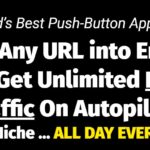There are plenty of ways to make money with your blog.
Your job is to decide which one is right for you and put it to work.
Take note that you may need to do some experimentation to discover which tactic – or combination of tactics – is the most profitable for your blog.
Let’s take a look at seven of the most common and profitable monetization tactics…
Sell Your Own Offers
This tends to be the most profitable strategy for most people since you’ll always make more money selling your own offers versus promoting someone else’s products and services.
And better yet, you also get the customer mailing list, which will be your most valuable asset.
Promote Affiliate Offers
Another way to make money with your blog is to sell other people’s products and services.
Here are the keys to this strategy…
Do Your Due Diligence
You need to thoroughly review each product or service you intend to sell. Don’t even think of selling something that you wouldn’t use yourself. Ask: would I recommend this to my best friend or mother? If the answer is no, then don’t recommend it to your blog readers either.
Choose a Profitable Offer
You want to choose an offer that’s both popular (something your audience really wants) as well as profitable (high-converting with nice commissions).
Presell the Offer
Don’t just put links on your blog and expect big commissions. You’ll sell far more products if you presell the offer, such as by publishing a series of posts focused on selling a particular product. You might also create product reviews and comparisons to help generate sales.
Next…
Sell Ads
Another monetization method is to sell advertising space to others.
Take these two steps:
- Approve all advertisers (and their advertisements) personally. Sure, you could set a system up to sell advertising automatically using a script, but it’s better for you to check out the advertisers and their ads to be sure they’re selling high-quality, relevant offers that you feel comfortable having your brand, and reputation and name attached to.
- Check your niche to help determine pricing. How much are others in your niche charging for similar ad spots? Your ad pricing will be influenced by your niche, the quantity and quality of your traffic, and the ad placement. (E.G., a header banner is worth more than a tiny ad at the bottom of the page.)
Note that you can also sell “sponsorships” – this is basically like selling ad spots, except advertisers are referred to as sponsors (which makes visitors less likely to turn on their ad defence shields), and their ads are more visible on your blog.
For example, you may publish “sponsored posts” (where sponsors pay you to publish a post).
Just be sure you add a disclaimer when you publish a sponsored post.
Next…
Insert Google Ads (Or Similar)
The idea here is to insert ads that pay you for specific actions, such as when your visitors click on the ad or fill in a form.
You can find these CPA (cost per action) offers using Google AdSense (https://www.google.com/adsense/) or a site like MaxBounty.com.
Sell Access to Premium Posts
The idea here is to create regular posts (such as weekly) that are behind a paywall.
In a sense, what you’re doing is creating a membership subscription that gives people access to your additional premium posts in exchange for a fee (e.g., $10 or $20 per month).
Offer “Ad Free” Reading
Some people don’t like reading a blog with advertising on it.
You can offer these readers an option: they can get an ad-free experience in exchange for a monthly fee.
Bottom line: all the content on your blog is available to everyone.
Those who buy an ad-free membership get the content without seeing any ads (this includes your own ads, by the way).
Create a Product From the Posts
Once you’ve had your blog up and running for a while, you’ll accumulate a lot of content – and some of it will be very popular.
You can capitalize on this popularity by compiling your best posts to create a book.
You can sell this book directly from your blog as a PDF, you can create a Kindle book for Amazon, or you can even create a hardcopy book (using a service like CreateSpace.com).
How to Promote?
Once you select your monetization strategy (which may be a single method mentioned above or a combination), then you need to promote your chosen options. Here are three ways to do it…
- Use images. You can put banner ads and other graphical ads in your sidebar, header, footer, and even in popup windows.
- Insert ads in content. You can insert the ads in the middle of the content, or you can even make the entire post into a soft-sell promotion or a direct-response advertisement.
- Put ads in lead magnets. Here you offer free lead magnets to your blog readers, and then include promotions inside the lead magnet itself as well as in follow-up emails you send.
Now let’s wrap things up…
Your Turn
Before you go any further in planning your blog, you’ll want to plan out your monetization strategy. Answer these questions:
- Which tactics seem to be a good fit for your blog? (Note that you may start with one tactic – such as selling affiliate products – and change over to selling your own products as you create them.)
- Will you use one tactic or a combination? If you’re doing a combination, which tactic will be your PRIMARY focus? (Note that you should choose one primary tactic so as not to dilute your efforts.)
- How will you promote your monetization option?
Be as detailed as possible when you plan out your strategy.
Don’t forget, you should still test and track your strategy in order to produce the best results.
This includes:
- Testing different tactics to see which ones are more profitable for your blog.
- Testing different ad placements (e.g., where do ads get the best response on your blog)?
- Testing different ads (including the headline, graphics and call to action).
Next> The Timeless Strategy For Creating Content That Presells A Product










